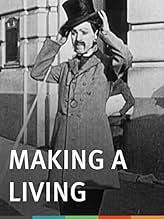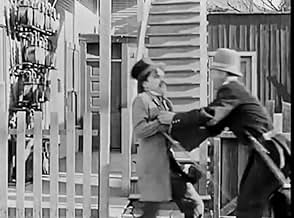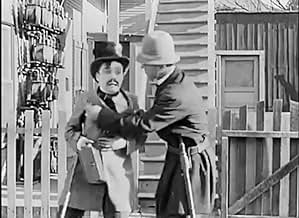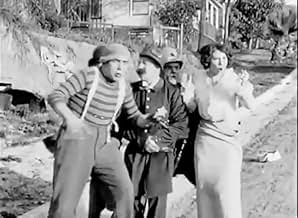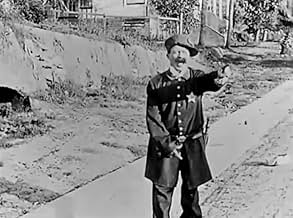अपनी भाषा में प्लॉट जोड़ेंAn out-of-work swindler takes a job as a reporter. After witnessing a car go over cliff, he grabs a rival reporter's camera and races to the newspaper office to enter the photo as his own. H... सभी पढ़ेंAn out-of-work swindler takes a job as a reporter. After witnessing a car go over cliff, he grabs a rival reporter's camera and races to the newspaper office to enter the photo as his own. His rival is delayed when he gets caught in a woman's bedroom by her jealous husband. The s... सभी पढ़ेंAn out-of-work swindler takes a job as a reporter. After witnessing a car go over cliff, he grabs a rival reporter's camera and races to the newspaper office to enter the photo as his own. His rival is delayed when he gets caught in a woman's bedroom by her jealous husband. The swindler follows the distribution of the paper containing his 'scoop' around town where he ... सभी पढ़ें
- Tough guy
- (बिना क्रेडिट के)
- Jealous Husband's Wife
- (बिना क्रेडिट के)
- Policeman
- (बिना क्रेडिट के)
- …
- Mother
- (बिना क्रेडिट के)
- Girl
- (बिना क्रेडिट के)
- Jealous Husband
- (बिना क्रेडिट के)
- Seated Man with Editor
- (बिना क्रेडिट के)
- Newspaper Editor
- (बिना क्रेडिट के)
- Wreck Bystander
- (बिना क्रेडिट के)
- Daughter
- (बिना क्रेडिट के)
- Cops
- (बिना क्रेडिट के)
- Reporter
- (बिना क्रेडिट के)
- Bald Man in Newspaper Office
- (बिना क्रेडिट के)
- Cop at Apartment Steps
- (बिना क्रेडिट के)
- Onlooker
- (बिना क्रेडिट के)
फ़ीचर्ड समीक्षाएं
Chaplin here, in his very first movie, plays a swindler masquerading as a reporter--or at least I think so. The movie moves along at such a hectic pace that it is a little confusing. Like all Keystone movies of that era, it was a silly bit of fluff. But still, it had its moments and is generally is pretty funny.
One memorable scene--memorable for its silliness--is the scene where a car gets into an accident and a reporter (Charlie? I am not sure) interviews a survivor while pinned in the wreck! That one bit of business was funny as hell. Any former present or former journalist, in particular, would appreciate it.
The first thing we notice is that the familiar costume hasn't been developed yet. In the very first shot, when Chaplin approaches his co-star (and director) Henry Lehrman to ask for a hand-out, it takes us a moment to adjust to his exotic appearance: he wears a top hat, tan frock coat, and droopy mustache. He looks a bit seedy but he's not exactly a tramp, more like an eccentric gent who is down on his luck. It's interesting to observe Chaplin in this extended opening sequence as he puts the touch on a man who is, apparently, a total stranger. He engages Lehrman in light conversation, examines the man's ring, briefly pretends to steal it, chuckles winningly, and then gets down to the business of genteel pan-handling. At first Lehrman refuses him a loan, but when he relents and offers cash Chaplin suddenly turns him down -- and then, as the offer is withdrawn, quickly grabs it. It's a nice little scene, more relaxed and nuanced than what we might expect.
All that follows is more conventional, as it details the escalating (and increasingly violent) rivalry between Chaplin and Lehrman, first over the same girl and then over the same job, at a newspaper office. Along the way we recognize some Chaplin expressions and mannerisms familiar from later performances, but we also note that Charlie's character is decidedly unsympathetic: he's a con man who repeatedly double-crosses his reluctant benefactor, Lehrman. At one point during a battle Chaplin holds Lehrman at bay with his walking stick, as he later would with Eric Campbell in The Rink (1916), but The Little Tramp seems worlds away. Eventually, when Lehrman manages to take some photos at the scene of a car accident, Charlie steals his camera and attempts to pass off the photos as his own. What a scoundrel!
For a newcomer to movie-making Chaplin appears perfectly relaxed before the camera. Despite all the scuffling and running around that takes place here, both Chaplin and Lehrman (who doesn't display much screen presence) give performances that are noticeably more restrained than the Keystone norm of the time. Towards the end, when Chester Conklin appears as a cop, his grotesque makeup and out-sized reactions look quite exaggerated in contrast to the two leads. It's also interesting to observe that Chaplin and Lehrman, who quickly developed an intense mutual antipathy off-camera, spend most of their on-screen time together as adversaries, both in this film and in Kids' Auto Race, made soon afterward. It seems that Chaplin was signaling, from the very outset, that he would not passively submit to direction from others -- or at least not from Henry Lehrman. And it wouldn't be long after this, just a few months, before Chaplin would be directing his own work, and his brilliant career would be launched in earnest.
As a comedy, it fails to elicit a single chuckle. And the only interesting bit of filmmaking comes at the very end when we see Chaplin and another actor jumping onto the front of a moving streetcar. The plot thickens no further!
Cinema buffs and Chaplin fans will find this film of interest as the debut of one of cinema's finest talents, but casual fans, and particularly fans of the Little Tramp, are better served skipping this one and watching Chaplin's second effort, Kid Races at Venice (1914), which is a far more successful comedy and features the Tramp's debut.
Many of Charlie's mannerisms are already very recognizable, and it is interesting to consider how similar his stage acting was to his film acting, since his style is already so clear. Consider his behavior upon noticing the Help Wanted sign, as well as the extensive fight scenes, which are even more breathless here than usual, since the pace of the film is so much faster than many of his short comedies of the time, given the primitive filming equipment.
Making A Living is a very unique film in Chaplin's filmography, not only because it is his first screen appearance, but also because it represents a real testing period in which he was truly unsure of himself as a screen actor. One cannot deny that it is interesting to consider how Chaplin looked back on this film in forming his persona, and what he thought worked here and what he should change. Also of note is the film's final shot, which features a stunt gag, something that would be very common in his later short comedies of this period.
Some have said that this is a film only for Chaplin fans and that casual fans of silent film should skip it, but I disagree. Chaplin is considered by many to be the greatest screen comedian of all time, but if you keep in mind that this is his first screen appearance and therefore not one of the greatest silent comedies of all time, I should think that any viewer with even a mild interest in silent film should find it interesting and entertaining.
He did do better than 'Making a Living', his debut. Can understand why the Keystone period suffered from not being as best remembered or highly remembered than his later efforts, but they are mainly decent and important in their own right. 'Making a Living' is a long way from a career high, but does have historical significance for obvious reasons.
'Making a Living' is not as hilarious, charming or touching as his later work and a good deal of other shorts in the same period. The story is flimsy and the production values not as audacious. The comedy is mildly amusing really at best.
For someone who was new to the film industry and had literally just moved on from their stage background, 'Making a Living' is not bad at all.
While not audacious, the film hardly looks ugly, is more than competently directed and is appealingly played. Chaplin looks comfortable for so early on, though his style was still evolving and not properly found or settled yet, and shows his stage expertise while opening it up that it doesn't become stagy or repetitive shtick.
Although the humour, charm and emotion was done better and became more refined later, 'Making a Living' does have moments where it is humorous, sweet and easy to like, though the emotion is not quite there. It moves quickly and doesn't feel too long or short.
In conclusion, interesting and worthwhile but not one that makes one leap out of their chair. 6/10 Bethany Cox
क्या आपको पता है
- ट्रिवियाFilm debut of Charles Chaplin. NOTE: One of the few films in those early years in which he does not play the Tramp.
- कनेक्शनFeatured in Hollywood and the Stars: The Funny Men: Part 1 (1963)
टॉप पसंद
विवरण
- रिलीज़ की तारीख़
- कंट्री ऑफ़ ओरिजिन
- आधिकारिक साइटें
- भाषाएं
- इस रूप में भी जाना जाता है
- Take My Picture
- उत्पादन कंपनी
- IMDbPro पर और कंपनी क्रेडिट देखें
- चलने की अवधि
- 11 मि
- रंग
- ध्वनि मिश्रण
- पक्ष अनुपात
- 1.33 : 1

